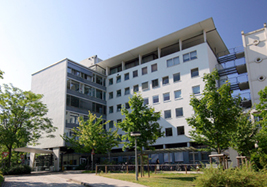Lungs in Good Hands

(Part II)
The lung is a vital organ. In the Department of Thoracic Surgery, malignant diseases such as lung cancer and lung metastases are carefully diagnosed and treated using minimally invasive surgical procedures.
Looking into the chest with a camera
A major focus in the Department of Thoracic Surgery is video-assisted thoracoscopic (VATS) surgery for lung cancer. In this, a rod-like video camera passes through a few centimeter-sized skin sections to allow a view into the operating area. Thus, ever more complicated operations can be performed minimally invasively. "Numerous studies have already proven that a VATS resection can achieve complete tumor removal at least as safely as with open surgery," says Professor Dr. Bernward Passlick, Medical Director of the Department of Thoracic Surgery at the Medical Center - University of Freiburg. The video system's optical magnification has advantages for the operator. For example, lymph nodes can be removed much more precisely because hidden areas in the thoracic cavity can be illuminated. Minimally invasive operations also have significant advantages for patients: less tissue damage and thus less pain and fewer inflammatory reactions. Many patients are able to recover faster and return to everyday life more quickly. As a rule, employed people can resume work swiftly after brief rehabilitation. Older patients and those with concomitant diseases can also be treated successfully. However, complex minimally invasive procedures can only be performed by specially trained surgeons with excellent technical equipment.
Pleural mesotheliomas from asbestos
However, not all diseases can be treated minimally invasively. For example, asbestos often provokes pleural mesotheliomas (tumors), which sometimes appear only decades later. Typical mutations can be displayed using modern X-ray and CT examinations. The question of whether malignant pleural mesothelioma actually lies behind these mutations can be clarified by a subsequent chest endoscopy. If a tumor is present, the physicians can try to reduce the tumor burden by removing the pleura, and sometimes also the visceral pleura and diaphragm, in order to improve the chances for successful medicinal therapy. In the Department of Thoracic Surgery, an especially lung-conserving procedure is used for the removal of pleural mesotheliomas in order to keep post-surgical restrictions to the minimum possible. The removal of the pleura is combined with chemotherapy, which is carried out during chest surgery in order to increase the effectiveness of the treatment. This intensive but at the same time conserving treatment of pleural mesotheliomas has so far only been offered in a few centers in Germany, meaning that many patients from far away visit the Department of Thoracic Surgery for this form of therapy.
Removing as little healthy lung tissue as possible in pulmonary metastases
A further core area in the Department of Thoracic Surgery is the surgical removal of pulmonary metastases. The most important goal is to remove as little healthy lung tissue as possible. In tissue-conserving operations, the metastases are quickly and precisely removed using a high-energy laser, and the remaining lung tissue is then sealed. The prospects of success for the operation are mainly determined by the behavior of the primary tumor. A smaller number of metastases always make for a more positive prognosis. The prospects for healing are good, even if a lot of time passes between the occurrence of the primary tumor and the metastases. If pulmonary metastases recur, further surgery may be appropriate. However, this again depends on the nature of the primary tumor and other factors which a thoracic surgeon must assess.
See also:
Back